
A commodity market is a market that trades in the primary economic sector rather than manufactured products, such as cocoa, fruit and sugar. Hard commodities are mined, such as gold and oil. Futures contracts are the oldest way of investing in commodities. Commodity markets can include physical trading and derivatives trading using spot prices, forwards, futures, and options on futures. Farmers have used a simple form of derivative trading in the commodity market for centuries for price risk management.

The coat of arms of Ontario is the armorial emblem representing the Canadian province of Ontario. The arms contain symbols reflecting Ontario's British heritage, along with local symbols. At the upper part of the shield is the red cross of St. George, representing England. The lower portion of the shield features three golden maple leaves on a green background.

The flag of Minnesota is the state flag of the U.S. state of Minnesota. Its design features a modified version of the seal of Minnesota emblazoned on a blue field. The first version of the flag was adopted in 1893, in advance of the state's mounting an exhibition at the 1893 Chicago World's Fair. It was significantly revised in 1957 and received a minor update in 1983.

The coat of arms of Toronto, Ontario, Canada, was designed by Robert Watt, the Chief Herald of Canada at the time, for the City of Toronto after its amalgamation in 1998. The arms were granted by the Canadian Heraldic Authority on 11 January 1999.

The coat of arms of North Dakota was created for use by the state government and National Guard units. An image of the coat of arms is seen on the flag of the governor of North Dakota and a short discussion of its use can be found at the North Dakota state government website.

The great seal of the state of Delaware was first adopted on January 17, 1777, with the current version being adopted April 29, 2004. It contains the state coat of arms surrounded by an inscription.

The state emblem of Uzbekistan was formally adopted on July 2, 1992 by the newly establish Republic of Uzbekistan. It bears many similarities to the emblem of the previous Uzbek SSR, which Republic of Uzbekistan succeeded. Like other post-Soviet republics whose symbols do not predate the October Revolution, the current emblem retains some components of the Soviet one. Prior to 1992, Uzbekistan had an emblem similar to all other Soviet Republics, with standard communist emblems and insignia.

The flags of New York City include the flag of New York City, the respective flags of the boroughs of The Bronx, Brooklyn, Manhattan, Queens, and Staten Island, and flags of certain city departments. The city flag is a vertical tricolor in blue, white, and orange and charged in the center bar with the seal of New York City in blue. The tricolor design is derived from the flag of the Dutch Republic—the Prince's Flag—as used in New Amsterdam in 1625.
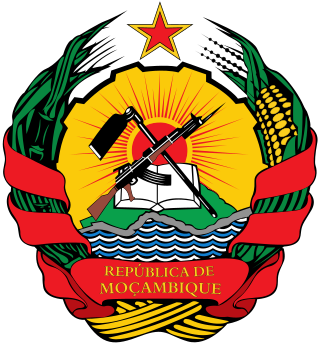
The national emblem of Mozambique was adopted in 1990 in the Constitution of Mozambique article 194. The article clearly states the design and meaning of the device. It shows a gear wheel, bordered by corn stalks and sugarcane. In the middle there is a red sun over a map of Mozambique in green, and blue waves, an AK-47 crossed with a hoe, and a book. The wreath is tied with a ribbon bearing the name of the country. The emblem is "socialist heraldry" style similar to those of the Soviet republics.
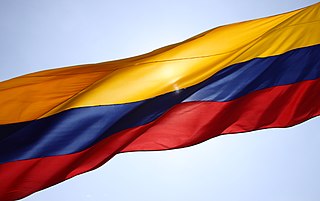
The National symbols of Colombia are the symbols which represent the national identity of the Republic of Colombia as a sovereign state. The national symbols intend to represent the Colombian identity by creating visual, verbal cultural iconic representations of the national people, values, goals, and history.

Chinese culture attaches certain values to colours, like which colours are considered auspicious (吉利) or inauspicious (不利). The Chinese word for "colour" is yánsè (顏色). In Classical Chinese, the character sè (色) more accurately meant "colour in the face", or "emotion". It was generally used alone and often implied sexual desire or desirability. During the Tang Dynasty, the word yánsè came to mean 'all colour'. A Chinese idiom with the meaning “many colours” or “multi-coloured”, Wǔyánliùsè (五顏六色), can also mean 'colours' in general.
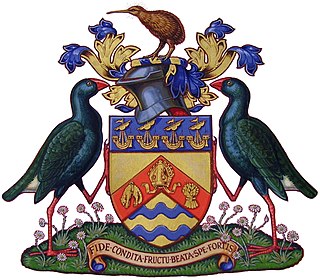
The Coat of Arms of the City of Christchurch, also known as the armorial bearings, is the official symbol of the City of Christchurch, New Zealand. They were granted to the City by the College of Arms by Letters Patent on 21 February, 1949.

The official symbols of the head of state are the state insignia of the president of Ukraine. Pursuant to presidential decree of November 29, 1999, they include four items: colour (standard), collar, bulawa and official seal. Some of the items of the set are adopted from the Cossack regalia (Kleinodien) that once were accepted from the King of Poland Stefan Batory.
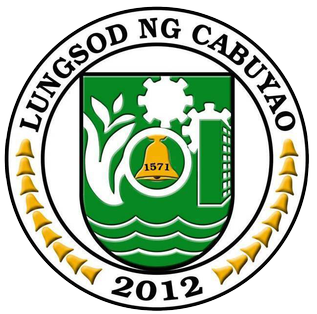
The Seal of Cabuyao is one of the official symbols of the city of Cabuyao.
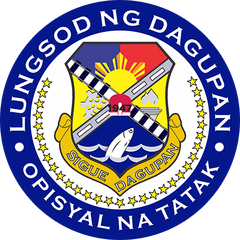
The Seal of Dagupan is one of the official symbols of Dagupan.
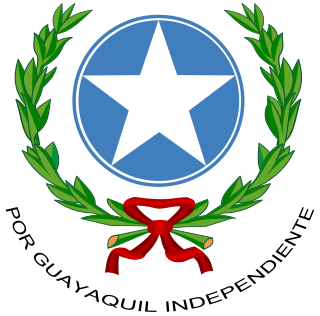
The coat of arms of Guayaquil is used for the Ecuadorian city of Guayaquil. Adopted in 1920, it's composed of a circle in blue with an inscribed silver star. The circumference is surrounded on both sides by two olive branches in the shape of a crown, linked at the bottom by a ribbon of gules. Under the ribbon is the slogan "Por Guayaquil independiente". It usually appears with an oval border in blue, although this is not an official version.
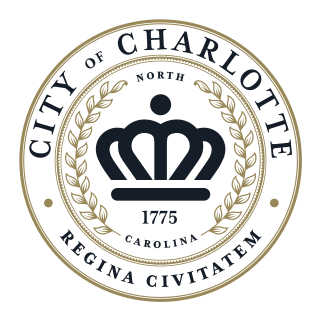
The Seal of Charlotte was first established during the tenure of mayor Charles A. Bland, and was designed over a period stretching from 1911 to 1915. It was adopted on the city's first flag in 1929, which still remains in use today. This seal itself was rescinded at an unknown date and replaced with the present one. It is used to authorize executive documents from the city, including, but not limited to, mayoral proclamations and resolutions from the city council.

The flag of El Paso is the official municipal flag of El Paso, Texas. The current design, an augmentation of El Paso's seal in the center of a dark blue field, has been in place since 1962.
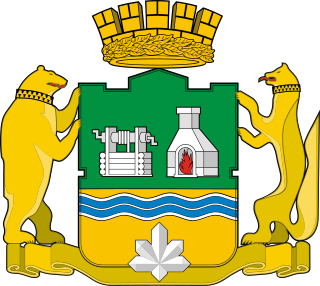
The coat of arms of Yekaterinburg is the official municipal coat of arms of Yekaterinburg, Russia. The current symbol was adopted on 23 May 2008 and consists of a French shield divided horizontally into two fields, with a white mine shaft and a white furnace within the top field, which is green, and a blue wavy bend within the bottom field, which is gold. A gold bear and gold sable are located to the left and right of the shield, respectively. A gold crown with a gold laurel wreath is located above the shield and a gold ribbon is located below the shield. A grey druse is located at the bottom center of the shield.
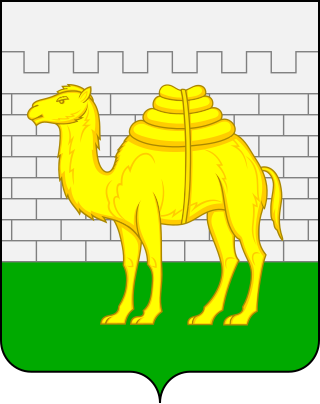
The coat of arms of Chelyabinsk is the official municipal coat of arms of Chelyabinsk, Russia. The current design, adopted on 12 September 2000 by the City Duma, features a gold camel loaded with goods on its back. The shield is divided into two fields, with the top being taller than the first. The top field is silver and is designed to resemble a brick wall. The bottom field is green.




















